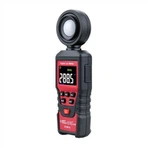What is the principle of sound level meter?
The sound level meter is a basic noise measuring instrument. It is an electronic instrument, but it is different from objective electronic instruments such as voltmeters.
When converting acoustic signals into electrical signals, the time characteristics of the human ear's response speed to sound waves can be simulated;
There are frequency characteristics with different sensitivities to high and low frequencies and intensity characteristics that change the frequency characteristics at different loudnesses. Therefore, a sound level meter is a subjective electronic instrument.
The working principle of the sound level meter is:
The microphone converts the sound into an electrical signal, and then the preamplifier changes the impedance to match the microphone and the attenuator. The amplifier adds the output signal to the weighting network and performs frequency weighting on the signal (or an external filter);
Then the signal is amplified to a certain amplitude through the attenuator and amplifier, and then sent to the effective value detector (or external level recorder), and the value of the noise level is given on the indicator meter.
1) A microphone is a device that converts sound pressure signals into voltage signals. It is also called a microphone. It is the sensor of a sound level meter. Common microphones include crystal, electret, moving coil and condenser.
The dynamic microphone is composed of a vibrating diaphragm, a movable coil, a permanent magnet and a transformer.
The vibrating diaphragm begins to vibrate after being subjected to sound wave pressure, and drives the movable coil installed with it to vibrate in the magnetic field to generate induced current.
This current changes according to the amount of sound wave pressure the vibrating diaphragm is subjected to. The greater the sound pressure, the greater the current generated; the lower the sound pressure, the smaller the current generated.
The condenser microphone is mainly composed of a metal diaphragm and closely spaced metal electrodes. It is essentially a plate capacitor.
The metal diaphragm and the metal electrode constitute the two plates of the flat capacitor. When the diaphragm is affected by sound pressure, the diaphragm deforms, causing the distance between the two plates to change;
As a result, the capacitance is changed, and the voltage in the bit measurement circuit also changes, realizing the function of converting the sound pressure signal into a voltage signal.
Condenser microphone is an ideal microphone in acoustic measurement. It has the advantages of large dynamic range, flat frequency response, high sensitivity and good stability in general measurement environments, so it is widely used.
Since the output impedance of the condenser microphone is very high, impedance conversion needs to be performed through a preamplifier. The preamplifier is installed inside the sound level meter close to where the condenser microphone is installed.
2) Amplifier
Generally, two-stage amplifiers are used, namely input amplifier and output amplifier, whose function is to amplify weak electrical signals.
The input attenuator and output attenuator are used to change the attenuation of the input signal and the attenuation of the output signal so that the meter pointer points at the appropriate position.
The adjustment range of the attenuator used in the input amplifier is the low end of the measurement, and the adjustment range of the attenuator used in the output amplifier is the high end of the measurement.
Many sound level meters have a cutoff of 70dB for the high and low ends.
3) Weighted network
In order to simulate the different sensitivities of human hearing at different frequencies, the sound level meter is equipped with a network that can simulate the hearing characteristics of the human ear and modify the electrical signal to an approximate value of the sense of hearing. This network is called a weighting network .
The sound pressure level measured through the weighting network is no longer the sound pressure level of an objective physical quantity (called linear sound pressure level), but the sound pressure level modified by the sense of hearing, called weighted sound level or noise level.






